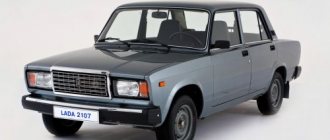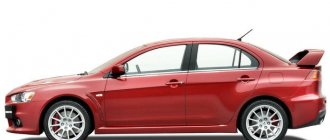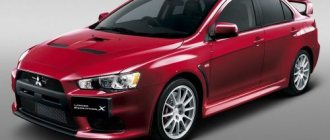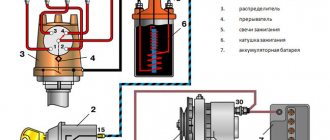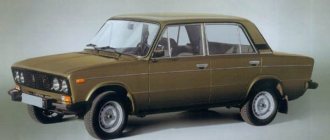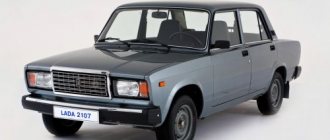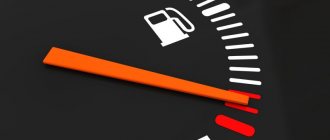When buying a car, the owner is interested in the question of fuel consumption. The fuel consumption of the VAZ 2112 16 in comparison with other models of this car brand is considered economical and acceptable. But it is worth considering that even the driver depends on gasoline consumption for a certain distance. To understand this issue in more detail, it is necessary to consider all the reasons and nuances that affect the decrease or increase in fuel consumption. The actual fuel consumption of the Lada 2112 in the city is approximately 8 liters per 100 kilometers.
If your car's engine uses more fuel, then you need to find out all the direct factors that influence this.
Average fuel consumption values for VAZ 2112
When purchasing a car, you must immediately know the average fuel consumption of the engine under three main conditions.
| Engine | Consumption (highway) | Consumption (city) | Consumption (mixed cycle) |
| 1.5 5-mech | 5.5 l/100 km | 9.1 l/100 km | 7.6 l/100 km |
| 1.6 5-mech | 6 l/100 km | 10 l/100 km | 7.5 l/100 km |
| 1.5i 5-mech | 5.5 l/100 km | 8.8 l/100 km | 7.2 l/100 km |
The first is the fuel consumption of the VAZ 2112 on the highway, which averages from 9 to 10 liters. In rural areas, off-road - from 9.5 liters. In a combined cycle, fuel consumption on a VAZ 2112 should be at least 7.7 liters. If your VAZ car requires much more, then you should pay attention to the following points:
- like driving style;
- engine's type;
- car mileage;
- specifications;
- fuel quality.
Driving maneuverabilityVAZ
The first thing auto mechanics advise you to pay attention to when fuel consumption is high is your driving style. Lada is a car that does not tolerate slow acceleration or slow acceleration.
The gasoline consumption of a VAZ 2112 per 100 km in the city will be up to 7.5 liters, only when the car drives smoothly, without jerking, switching to different speeds, and also choosing the optimal driving style in summer and winter.
Keep in mind that in winter up to 1 liter is needed to warm up the car. If you do not do this, then the engine will require a lot more gasoline when driving to warm up the system while driving.
Engine type VAZ
The 2112 hatchback has a 1.6-liter fuel-injected engine with 16 valves. A 5-speed manual transmission is installed. For such an engine, the fuel consumption of the VAZ 2112 (16 valves) is an average of 7.7 liters.
As for the engine type. If the VAZ 2112 fuel consumption per 100 km exceeds 8 liters, then you need to pay attention:
- fuel filter;
- valve filter;
- nozzles;
- candles;
- valve;
- oxygen sensor.
You should also check the condition and adjustment of the electronics and its reliability.
Owner reviews
“I decided not to spend money on my first car and bought a VAZ 2112. I’ve been driving it for 10 years. If you take care of the car, as I do, then it will live for a very long time. He never let me down, although the situations on the roads were different. The only thing I don't like is the design, it's too simple. But everything in the cabin is great. There is a lot of space, it is well equipped, and there is a lot of useful stuff on the dashboard. I will also note the build quality, which is not typical for our cars. The engine is peppy and drives well, both on regular roads and off-road. Too bad it's a big expense. I spend up to 11 liters of fuel,” writes Georgy from Krasnodar.
This review was left by Kirill from Rostov:
“To my great regret, my old car broke down for good. I urgently needed some kind of car to carry out normal everyday tasks. There wasn't a lot of money, since most of it was spent on repairing the previous car. I had enough for the VAZ 2112. I can’t say anything bad about the car, it’s a worthy model. There is plenty of space for both passengers and things in the trunk. The engine allows you to drive at a decent speed on the highway, and also feel comfortable in the city. It uses a lot of fuel, but the car is good.”
“My father gave me the car after he bought himself a new foreign car. My joy knew no bounds, since I received my license a long time ago, and there was nothing to constantly practice on. I like everything about the car. A pleasant rounded design, a modern and spacious interior and a peppy engine evoke only positive emotions. I was impressed by the sound insulation, which does not allow sounds from the street to pass through at all. I travel very often, so I use a lot of fuel. In the summer I spend up to 12 liters in the city, a little more with air conditioning. In winter it’s about 13,” notes Nikolai from Yekaterinburg.
And this is what Artem from Smolensk writes about his car:
“I bought the car from a dealership in 2005. I drove it for almost five years and decided to sell it. But I did this solely in order not to spoil the impression of our cars, since by this period of use various problems usually begin, and I don’t want to tinker with the car. I was completely satisfied with it and saw no shortcomings at all. I would like to note that the interior was quite modern in terms of equipment, which made us proud of our auto industry. Here you can find high build quality, good sound insulation, and pleasant finishing materials. Consumption varies greatly and depends on the time of year. In winter, on average, it was 11-12 liters, in summer – up to 10.”
“Before I was twelve, I had several cars, but there were problems with all of them. However, here, to my surprise, everything was smooth throughout the entire time of use. I have never been to a service center, I changed all the consumables myself. I was surprised by the technical equipment, which is characterized by high reliability and good cross-country ability on any road conditions. The engine would be a little more powerful, and you simply couldn’t find a better car, especially at such a low cost. One moment, of course, spoiled the impression a little. This is a consumption that could reach 13 liters in the city and 10 on the highway. This is too much for such a small engine,” writes Vladimir from Tver.
The car received these words from Vitaly from Abakan:
“I didn’t like the car at all. I struggled with it for a couple of years and sold it. Yes, there are a lot of spare parts for it and they are cheap. But, first of all, this means that they will have to be changed very often. I bought it, installed it, drove it a little and everything was new again. The only positive thing about the car is the interior, which has more or less decent equipment by the standards of that time. The car’s consumption was up to 12 liters.”
Car mileage
A very important point is the mileage of the car, as well as its condition. If this is a new car from a showroom, then all average fuel consumption indicators should match. If the car’s mileage has exceeded 100 thousand kilometers, then gasoline consumption may exceed the average.
It also depends on where the car was driven, on what roads, at what pace, and whether the engine was repaired. To find out exactly what gasoline consumption on a VAZ 2112 will be under your driving mode, fill the tank with 1 liter and check how far you can drive. Car mileage is the total number of kilometers that the car has traveled without repairing the engine and its main components.
Phase sensor
This sensor is not installed on 8-valve engines; it is present only on 16-valve versions of the “ten”. The main purpose of the controller is to provide the necessary data to the power unit control system. In accordance with these data, the system determines at what point in time and where to inject fuel, into which specific cylinder. Every owner of a VAZ 2110 should know where this device is located. If you open the engine compartment of the car, you will see that the regulator is located on the right side of the neck for filling the engine fluid.
In principle, if the regulator breaks, nothing bad will happen if you look at it from the point of view of the integrity of the vehicle. But failure of the controller will in any case provoke an increase in gasoline consumption. This is due to the fact that the electronic control system of the internal combustion engine will independently switch the gas distribution mechanism to standby mode. Accordingly, gasoline will begin to be supplied to all cylinders of the engine at once. And at first, the driver may not even know about it until he diagnoses the regulator or measures fuel consumption.
New phase sensor for VAZ 2110
Naturally, such a model of the domestic automobile industry as the “ten” is not the most modern and advanced car in terms of electronics. However, machines of this model are equipped with a wide variety of regulators and controllers. In this article, we did not talk about all the devices, but only about the most basic ones that every motorist should know about. You can find more detailed information in other articles on our website or in the service book for your car.
Machine Specifications
A Russian passenger car with a hatchback body with easy maneuverability, it has fairly good factory technical characteristics. In order for fuel consumption to remain constant and not increase, it is necessary to monitor the technical characteristics of the entire vehicle. Inspection at service stations, as well as computer diagnostics will help you with this.
Fuel quality
The fuel consumption at idle speed of the VAZ 2112 is affected by the quality of gasoline, as well as the ketone number of the liquid being refilled. An experienced driver can safely say that he noticed how fuel consumption changed not depending on driving style
, not from the engine or even from the filters, but from high-quality fuel. When driving a VAZ 2112, you should take into account its mileage, as well as what you put in the tank. Accordingly, the amount of fuel consumption is determined from this.
History of creation
The VAZ 2112 hatchback model was produced since 1999, becoming the successor to the 2110 sedan and 2111 station wagon. The “Twelfth” became a close analogue of the famous tenth model, but had a slightly shortened body.
As planned by the manufacturers, the 2112 was supposed to combine all the advantages of the “ten” and “eleven”, so the five-door hatchback was chosen as the body type. VAZ-2112 Pre-production (1994)
The 12th model began to be mass produced in 2000; it lasted 8 years on the assembly line. Unlike the sedan and station wagon of the tenth series, the assembly of the “dvenashka” was not transferred to the Ukrainian ones.
Although the twelfth model was positioned as an improved “ten”, the improvements here are very conditional and not always obvious. Therefore, the difference between these two models is not too big. AvtoVAZ designers continued to look for new solutions, as a result of which other lines and modifications appeared, which also have both their pros and cons.
How to regulate fuel consumption on a VAZ 2112
We have already considered the factors and reasons that affect the use of gasoline in the VAZ 2112. Now you need to know what needs to be done to prevent gasoline consumption from increasing or how to reduce it. The main points to prevent increased fuel consumption are:
- constantly change the fuel filter;
- monitor the operation of the engine system;
- change candles that become black and oily over the years - non-functional;
- watch the condition of the fuel pump mesh so that it does not fall into the glass;
- The catalyst and exhaust must function.
By adhering to these rules, you can save on fuel costs for the VAZ 2112 by 7.5 liters.
Basic rules for reducing gasoline consumption
An attentive driver must constantly monitor all indicators of the car. Monitor the oil level, monitor engine operation, and monitor all filters and strainers. If you bought a car that has already traveled a certain number of kilometers and its fuel consumption exceeds 10 liters, then you should immediately take the following actions:
- change oil (adjust level);
- replace the filter;
- check the quality of gasoline;
- observe the performance of the fuel pump;
- regulate driving maneuverability.
If all this does not lead to the desired result, then you need to do computer diagnostics of the car.
Interior
The interior of the car is simple and not very presentable. You won’t find any “bourgeois excesses” here. The only exception is electric windows and heated front seats, but this is not found in all modifications of the car.
The steering wheel is large and very antediluvian. The steering column is height adjustable only. Moreover, some models come without power steering and electric power steering, which is a significant disadvantage.
Torpedo Lada 2112 (2006-08)
To the right of the steering wheel is a console with a heater, radio, on-board computer (if equipped) and main keys. The heater, in theory, should be adjustable in order to separately heat the windows, top and bottom of the cabin, but in reality everything is heated at once. There are no airbags in the cabin.
The glove compartment is quite large and even has a backlight. The position of the exterior mirrors is adjusted by a special lever, but it is adjusted very mediocrely, so usually no one uses it.
A tall person is unlikely to be comfortable in the back row of seats, because his head will touch the ceiling. Long-legged people will also not be very comfortable, since there is quite a bit of space left to the front seats. The width of the cabin is cramped; only two passengers can be comfortably accommodated. Three people will fit, but they will be cramped.
Interior of Lada 2112 (1999–2008)
The rear windows are manual and constantly stick. As anyone who has ever owned a Lada, Zhiguli or any other AvtoVAZ product knows, the windows go down exactly to the level they want. Often it is completely impossible to lower the glass completely; it gets stuck in the middle and does not move anymore.
The rear row seats recline together or separately, which increases the size of the trunk, so you can put a fairly large load in the car.
Engines with different numbers of valves
Let's start with the fact that the consumption rate will be different for different types of engines, which differ in the number of valves and design features. The first tenth Lada was equipped with a 1.5 carburetor engine producing 72 hp. This modification was produced for a relatively short time, only 3 years (1996–1999).
Next, it’s time for injection engines. First, let's look at the 8-valve power unit. This engine could not boast of special dynamics and power of 76 hp. for volume 1.5 and 81 hp. for later 1.6. But fuel consumption in the city was slightly higher than 9 liters, and outside it dropped to 5.5 liters per 100 km.
The 16-valve engine was structurally new for the giant plant and, in a sense, revolutionary. Its volume could be 1.5 or 1.6 liters, with the former being more powerful. The average gasoline consumption in both cases is approximately the same - 7.2 - 7.3 liters (at least, this is what the manufacturer declares). At the same time, in the city it takes up to 9 liters, and on the highway some 5.5 liters.
| Engine, modification | Fuel consumption in the urban cycle, l/100km | Fuel consumption in the extra-urban cycle, l/100km | Fuel consumption in the combined cycle, l/100km |
| 2110 1.5 (72 hp) 8 valves, carburetor | 9,1 | 5,5 | 7,6 |
| 21101 1.6 (81 hp) 8 valves, injector | 7,5 | 5,3 | 7,2 |
| 21102 1.5 (78 hp) 8 valves, injector | 8,6 | 5,3 | 7,2 |
| 21103 1.5 (94 hp) 16 valves, injector | 8,8 | 5,5 | 7,2 |
| 21104 1.6 (89 hp) 16 valves, injector | 7,7 | 5,5 | 7,2 |
| 21106 engine OPEL 2.0 (148 hp) 16 valves, injector | 9,8 | 5,4 | 7,1 |
The fuel consumption of the VAZ 2112 hatchback will be almost the same, and the VAZ 2111 station wagon with the same power units is 0.1–0.3 liters per 100 km higher.
Financial life
Lada 2112 vaz112 1.5 16 › Logbook › Enormous fuel consumption of the car
Saransk, Russian Federation
Enormous car fuel consumption
It's not nice to throw money away when your car has high fuel consumption. Those who do not trust their own car to a car service try to find the reason for the enormous gas consumption on their own. Others, on the contrary, rush to the service station, where the technician begins to examine the car. And why, by and large, does a car consume a large amount of gasoline?
In fact, increased gasoline consumption may be the result of not one, but several troubles at once. Let's figure out what affects fuel consumption and whether it is possible to reduce gasoline consumption without the help of experts:
Inaccuracies in the electronic engine control system
car electronic sensors One of the main reasons for increased fuel consumption on modern cars is a malfunction of the engine control system. This is due to the incorrect operation of the sensors, which are designed for optimal calculation of the air-fuel mixture:
Temperature sensors (coolant and intake manifold).
Throttle position sensors (TPS).
Mass air flow sensor (MAF). Its service life is significantly reduced if the air filter is not changed in time.
Oxygen sensor (lambda probe).
The inaccuracies of these sensors to varying degrees are the result of a lean or rich mixture, which is expressed in loss of power and excessive fuel consumption. All these faults are difficult to figure out without diagnosing the car, but it is possible if you look for it by rebuilding the sensors.

